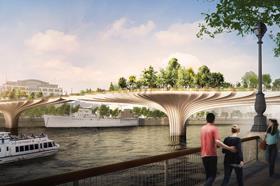We need more of the initiative and drive behind proposals such as London’s Garden Bridge

The start of a new year often sees us taking time to think differently and consider new ways to achieve what we want to do.
One of the construction-related news stories very early in the year was about a new pedestrian garden bridge in London, developed by actress Joanna Lumley, the innovative Heatherwick Studio, Transport for London and Arup.
To some it might be a fanciful idea or a pipe dream, but to others it’s innovative and a positive addition to the capital. We probably had similar thoughts about the London Eye and the Angel of the North, but these are now a familiar part of the skyline that we wouldn’t be without. (Isn’t 20-20 hindsight a wonderful thing?)
Whatever your views, the proposed garden bridge is certainly forward looking. It’s an example of thinking ahead to what might be and what’s possible to achieve with the right combination of interest, timing, political will and finance.
I say less of the 20:20 hindsight and more wide-eyed foresight, initiative and determination to make a difference
To use another example, we might not build an airport off the east coast of England, but the proposal has challenged the status quo on what the country needs to expand its air transport capacity.

Likewise, it took an Olympic Games to transform a neglected part of East London into a new place to live, work and spend our leisure time.
These examples are all very obvious changes to the built environment. Let’s not forget, however, those projects that are relatively or actually invisible but make a fundamental difference to how we live.
An efficient transport infrastructure helps to drive the economy forward, whether it’s through road widening, introducing better provision for cycling or bolder steps such as the introduction of HS2. One of the most significant transport projects in recent times, Crossrail, will be hidden from view but will make a radical difference to public transport in the capital.
At the same time, improvements to the information infrastructure and online environment are helping us to reduce our need to use transport networks, interacting instead in the ‘virtual’ world.
Key infrastructure is often only noticed when things go wrong. Witness the efforts of the energy network providers over the festive period to restore power to homes affected by extreme weather. If we hadn’t experienced those difficulties, I suspect very few members of the public would have spared a thought for how energy reaches their homes or whether there is the right level of investment in place to maintain that service.
Our ‘hidden’ infrastructure faces plenty of challenges as the country emerges from recession. In energy alone we face choices around nuclear, renewables and local versus centralised energy production – as well as the perennial challenge around using less energy in the first place. Hinkley Point is now a reality and we are seeing energy companies investing in shale gas production. In Yorkshire, work is underway on a huge project at the Drax power plant to switch coal-fired generators to sustainable biomass. Perhaps we wouldn’t have predicted these things a decade ago; today’s stargazers are now looking at solar panels that collect energy in space becoming a reality by 2025.
Suffice to say, our infrastructure is essential, and perhaps not well enough appreciated for the role it plays. I say less of the 20:20 hindsight and more wide-eyed foresight, initiative and determination to make a difference. It’s a tough resolution, but no doubt worth it.
Mike Putnam is the president and chief executive officer of Skanska UK


























No comments yet